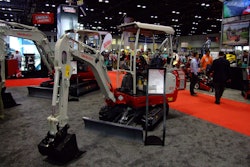 A Cat 972M loads an articulated truck.
A Cat 972M loads an articulated truck.UPDATE 4:10 p.m: Cat has issued a brief press release regarding Thursday’s raid of its facilities by federal agents. This story has been updated to reflect this new information.
Three of Caterpillar’s Illinois facilities received surprise visits from federal agencies Thursday morning as law enforcement officials seized documents and electronic records apparently pertaining to an ongoing investigation into the company’s tax strategy.
The news broke across several media outlets early Thursday afternoon, sending Caterpillar’s stock down by as much as 5 percent. At the time of this writing, shares had rebounded a bit but were still down 4.3 percent. According to MarketWatch it’s the biggest stock tumble the company has seen in eight months.
According to a report from the Peoria Journal Star, which first broke news of the raid, federal officials searched Cat’s main administration building in Peoria, a data center in East Peoria and a logistics center in Morton. The PJ Star report names the Internal Revenue Service, the Federal Deposit Insurance Corporation and the Commerce Department’s Bureau of Industry and Security among the agencies present during Thursday’s search.
In a brief press release sent late Thursday afternoon by Caterpillar, the company confirmed the raid and said federal agencies had executed a search and seizure warrant, noting that the company “is cooperating with law enforcement.”
In the release, Cat says it believes the raid to be part of an ongoing criminal investigation into its use of overseas profit shifting as a tax strategy.
“While the warrant is broadly drafted, we believe the execution of this search warrant is regarding, among other things, export filings that relate to the CSARL matter first disclosed in Caterpillar’s Form 10-K filed on February 17, 2015, and updated in Caterpillar’s most recent Form 10-K filed with the SEC on February 15, 2017,” the press release reads.
A wrongful termination lawsuit filed against the company by Daniel Schlicksup and heard in 2009 by a federal court first brought to light details of the company’s profit shifting strategy. Though Schlicksup settled his lawsuit against the company in 2012, the unearthed tax details have kept the company under federal scrutiny for nearly a decade.
Schlicksup alleged Cat used what he referred to as a “Swiss structure” and a “Bermuda structure” to avoid paying taxes by moving select profits to offshore shell companies located in Switzerland and Bermuda.
In March 2014, the heavy equipment maker testified in a Senate hearing held by the Subcommittee on Investigations to defend the profit shifting practice. A report by former Sen. Carl Levin (D – Michigan) found that while the company had done nothing illegal, it had successfully avoided paying around $2.4 billion in federal taxes. Sen. Rand Paul (R – Kentucky) defended Cat saying “We’ve got the wrong people on trial here. The tax code needs to be on trial here.”
As a result, the IRS reviewed Cat’s 2007 to 2009 tax returns and levied $1 billion in penalties and increased taxes in early 2015. Among those penalties was a retroactive taxing of profits earned from Caterpillar SARL, a Switzerland-based parts subsidiary.
The IRS penalties were preceded by a grand jury subpoena on Jan. 8, 2015, from the U.S. District Court for the Central District of Illinois requesting documents and information on the company’s cash movement between U.S. and non-U.S. subsidiaries.
During the search of Cat’s global headquarters building in Peoria, “at least some company employees were directed to the building’s cafeteria and were told to remain there and not leave,” the Star reports, adding, “those sequestered there include employees in the Treasury, tax and accounting divisions, as well as from executive offices.”












